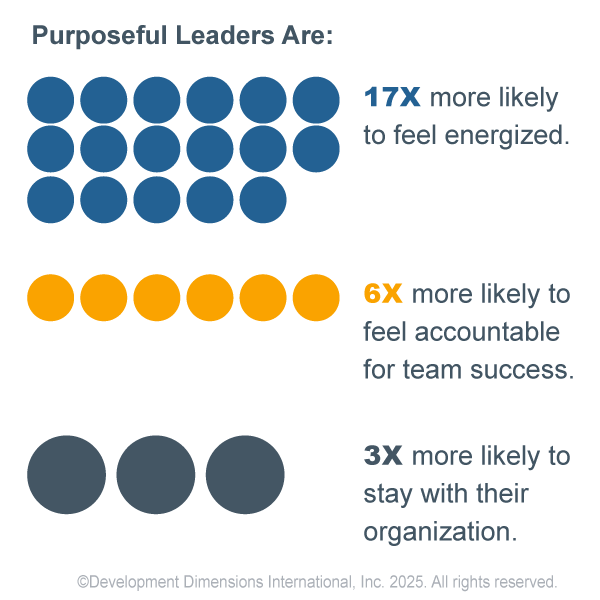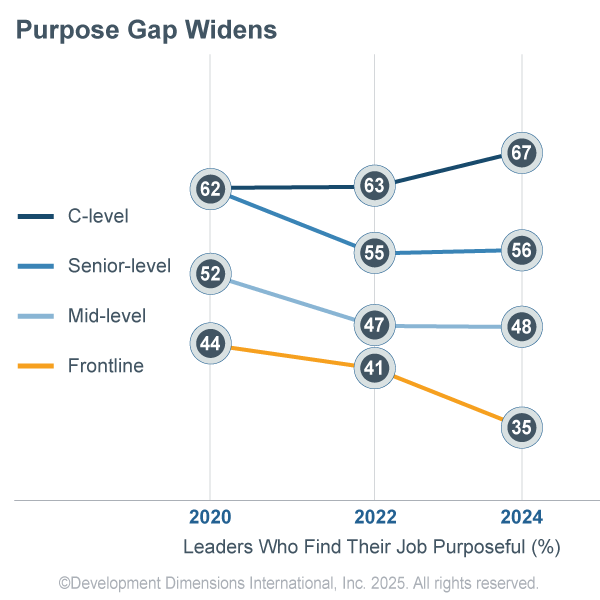Leadership purpose is fading across organizations, putting the vitality of our workplaces at risk. According to DDI’s Global Leadership Forecast 2025, only 35% of frontline leaders say they find their job purposeful. That’s a 20% drop since 2020. Mid-level and senior leaders don’t fare much better. Only 48% and 56%, respectively, say they have a strong personal vision.
Why is leadership purpose slipping? In short, it reflects the mounting stress leaders feel due to nonstop change, from pandemic aftershocks to AI transformation. Plus, role creep leaves leaders feeling disconnected, disengaged, and doubtful of their impact.
Yet one group bucks the trend: C-level leaders. In 2025, 67% say their job feels purposeful, up from 62% in 2020. Their closeness to strategy and vision likely fuels this rising sense of meaning.
This growing gap signals a crisis that learning and development (L&D) professionals must confront. Frontline leaders, the engine of execution, are overwhelmed by more demands and dwindling support. When they lose their “why,” companies face rising talent risks that threaten innovation, resilience, engagement, and retention.
Understanding and rekindling leadership purpose is crucial for organizational success. As driving motivation continues to decline, L&D holds the key to closing the gap. With the right strategies, L&D can help leaders at every level rediscover meaning in their work.
Understanding Leadership Purpose
Leadership purpose isn't just a buzzword; it's the foundational "why" behind a leader's actions. It links personal values to broader organizational and societal goals. At its core, purpose is what fuels leaders while connecting their work to something meaningful.
At its core, purpose is what fuels leaders while connecting their work to something meaningful.
Leaders with a professional calling are more motivated to pursue goals beyond profits or titles. A leader’s driving force is also highly personal and looks different based on their role. For example, senior or C-suite leaders may find their meaning in setting strategy, while frontline leaders may be fueled by helping their teams grow. The key is finding where personal mission can authentically connect to organizational objectives at any level.
What does this look like in practice? A nursing director who personally values patient dignity found his sense of meaning by aligning his leadership approach with his hospital's mission of compassionate care. He pivoted the focus of team huddles to patient stories rather than just metrics, connecting his personal values to organizational objectives, all while improving both staff engagement and patient outcomes.
Purpose-driven leadership doesn’t just benefit the leader; it also spurs teams toward meaningful shared goals.
The Importance of Leadership Purpose
Leadership purpose connects what a leader personally values to the organization’s broader mission, strengthening company culture. When leaders align their authentic motivations with organizational goals and clearly articulate this connection, teams build trust, unite around shared values, and understand what’s expected of them.
Purpose steadies teams, especially in uncertain times. When teams grasp both the organization’s “why” and how their leader authentically connects to it, they gain clarity to act on their own, think creatively, and focus on what matters most. This guidance builds resilience, fuels innovation, and helps them adapt through challenges.
High-potential employees are 4.8X more likely to leave if they don’t feel a sense of purpose in their role.
In contrast, leaders lacking driving motivation may trigger early warning signs like disengagement or falling morale. This isn’t just a culture issue; it’s a retention risk. And it gets worse when metrics take center stage and reduce meaningful work to numbers. Goals matter—but they can’t replace meaning. High-potential employees are 4.8X more likely to leave if they don’t feel a sense of purpose in their role.

The impact of a clear direction on performance speaks for itself. Purposeful leaders are:
- 17X more likely to feel energized.
- 6X more likely to feel accountable for team success.
- 3X more likely to stay with their organization.
When personal and organizational vision align, the payoff is clear: more motivated, engaged, and loyal leaders who drive better results.
The Current Crisis: Declining Sense of Purpose
Leaders’ connection to a sense of meaning in their work has declined sharply since 2020 for frontline, mid-level, and senior-level leaders alike. The drop is steepest at the frontline, revealing a widening gap across leadership levels.
Let’s take a closer look at what’s happening with leadership purpose.
Frontline Leaders Under Pressure
Why is sense of direction eroding fastest at the frontline? In short, these leaders are under immense pressure.

- Pandemic aftermath: In recent years, frontline leaders have dealt with one crisis after another—remote work shifts, staffing shortages, and team burnout—often without much support. Unlike executives, these leaders directly absorb daily disruptions while serving as the critical link between strategic decisions and anxious employees.
- Growing workload: Their roles have expanded, with more pressure to deliver on initiatives they had little voice in shaping. Many must do more with less, all while keeping team morale up.
- Career growth concerns: At the same time, career growth feels harder to reach. As companies flatten, chances to advance shrink. This leaves many feeling stuck and disconnected from both their personal “why” and their company’s mission.
It’s no shock, then, that trust has frayed. Only 28% of frontline leaders say they trust senior leadership, compared to nearly 40% at other levels. Without that trust, it's even harder for them to connect to a vision they didn’t help define and no longer feel supported to fulfill.
Mid- and Senior-Level Leaders: Pulled in Too Many Ways
While the drop in purpose is less severe for mid- and senior-level leaders, they face their own set of challenges.
- Strategic uncertainty: Ever-changing priorities and ongoing pressure to deliver results amid change make it hard to stay anchored in a clear guiding principle.
- Conflicting needs: These leaders are caught between competing stakeholder demands. They must balance financial targets and other metrics with more intangible, culture-driven priorities like employee well-being and building trust and transparency.
- Role insecurity: With growing skepticism toward the value of middle management, many leaders are left questioning their relevance and career path.
Growing Purpose in the C-Suite
Meanwhile, C-level leaders are the only group whose sense of meaning has grown—likely because their roles demand it.
- Proximity to vision: As the ones closest to strategic decision making, executives help shape and share vision. This direct connection to purpose—both in defining it and driving it forward—reinforces their driving motivation in day-to-day work.
Purpose vs. Company Goals
L&D teams play a unique role in helping leaders find their professional calling and connect it to business priorities. By designing learning journeys that honor personal values while supporting organizational objectives, L&D ensures leaders don’t have to choose between purpose and performance—they can use one to drive the other.
By designing learning journeys that honor personal values while supporting organizational objectives, L&D ensures leaders don’t have to choose between purpose and performance—they can use one to drive the other.
This work is especially crucial for frontline leaders, who often feel caught between executing metrics-driven strategies and maintaining meaningful team environments. Through targeted development, L&D helps these leaders articulate how their personal values connect to broader organizational goals, transforming potential friction into powerful alignment.
Often, alignment is already there—it just needs to be uncovered. When leaders see that connection, they’re more likely to feel fulfilled, motivated, and committed—both in their own path and their work.
Building Purpose from Within
Authentic leadership is built on a clear sense of personal purpose. This driving motivation is unique to each leader because it’s rooted in personal values and commitments ranging from integrity, compassion, or innovation to community, problem solving, or empowering others. For instance, a leader who values creativity may find their professional calling in building innovative teams, while one anchored in fairness may focus on making equitable decisions. By finding and embracing their core values, leaders can craft a genuine and enduring purpose that guides their actions even in challenging times.
By finding and embracing their core values, leaders can craft a genuine and enduring purpose that guides their actions even in challenging times.
Leadership assessments are a powerful way to help leaders uncover their core values. Reflective exercises prompt them to think about times they felt most aligned with their principles. To turn this reflection into action, leaders need regular feedback and coaching. When these tools are used together and tailored to your company’s culture and goals, they directly relate personal vision to leadership.
Still, even when leaders understand their values, living them consistently is challenging. Many struggle with purpose because of a gap between what they believe and how they behave. A leader may value transparency but withhold information during a crisis, eroding trust. Or they may promote collaboration but default to solo decision making. These gaps often stem from external pressures—office politics, tight deadlines, or fear of failure—that pull leaders away from their core beliefs. Regular self-reflection and peer feedback bridge this gap, turning values into purposeful action. Without this, even well-meaning leaders risk undermining their credibility and inner compass.
Real-world examples show the power of this alignment. Satya Nadella, Microsoft’s CEO, rooted his leadership in empathy, reshaping company culture to drive innovation and put customer connection first. Mary Barra, CEO of General Motors, led with open communication and accountability, guiding GM through a cultural shift toward sustainable mobility and transparency during challenging times. These leaders didn’t just proclaim their values—they lived them by example, weaving personal convictions into their actions. By doing so, they built trust, inspired change, and proved that purpose-driven leadership starts from within.
Traits of Purpose-Driven Leaders
Crafting a leadership purpose means building key traits that connect personal values to everyday actions. Leaders who embody these qualities are better able to inspire others, adapt to change, and make decisions anchored in a deeper sense of meaning.

Self-awareness and emotional intelligence
Leaders who know themselves understand their emotions and triggers, which helps them build trust and handle complex team dynamics with empathy. Emotional intelligence also fosters genuine connections so leaders can forge stronger relationships.

Authenticity and vulnerability
Authentic leaders stay true to their values. They inspire loyalty by being vulnerable, which makes them more relatable and encourages open dialog. This builds a culture of trust rooted in shared vision.

Compelling communication
Effective communicators share their higher aim clearly, rallying others around a common meaning with passion and clarity. Their words bridge values and action, motivating teams toward collective goals.

Resilience during setbacks
Resilient leaders persevere through challenges, drawing on their personal mission to stay focused and inspire confidence. They see setbacks as chances to commit to their core values.

Purpose-aligned decision making
Leaders rooted in a strong sense of meaning make choices that reflect their values, staying steady even under pressure. This alignment builds credibility and drives results.

Commitment to growth
Leaders dedicated to continuous growth seek feedback and new perspectives. As a result, they refine their personal mission over time. Lifelong learning keeps their leadership dynamic and relevant.
Strategies to Re-Awaken Purpose
Purposeful leaders create a ripple effect, fostering a culture where everyone feels connected to the mission. Frontline leaders work closest to employees, so helping them reconnect with their driving motivation has the greatest potential to impact the entire workplace. A renewed sense of vision can also boost leaders’ engagement, helping them inspire and retain talent.
Here are key strategies L&D teams can use to help leaders reconnect with their sense of meaning:
- Align personal values with culture: Guide discussions where leaders explore how their values (e.g., integrity) connect with cultural goals (e.g., transparency). Using real scenarios makes the link more tangible and energizes leaders to contribute.
- Create and revisit purpose statements: Writing a personal purpose statement helps leaders clarify what drives them, while revisiting it often keeps them focused. Reflective practices, supported by tools like values assessments, deepen self-awareness and reinforce connection to their goals.
- Set up coaching and mentoring: A mentor who grasps a leader’s motivations and goals can offer thoughtful guidance and encouragement to rekindle their professional calling.
- Create feedback loops: Involving frontline leaders in strategic discussions through feedback loops builds ownership of outcomes. Understanding the “why” behind decisions strengthens their connection to the organization’s mission.
- Build career paths and development opportunities: Clear career paths show leaders a future where their purpose can grow. Development opportunities, like training or stretch assignments, fuel motivation by aligning skills with long-term goals.
Ignite Leadership Purpose for a Lasting Impact
Leadership purpose, rooted in personal values, is the cornerstone of authentic, high-impact leadership. This is especially true for frontline leaders, who translate broader culture into daily team experiences and directly influence employee engagement.
When leaders align their values with their actions through self-awareness, reflection, and support systems like coaching, feedback, and career development, they build a guiding vision that inspires trust and drives results. That’s where L&D plays a vital role.
L&D professionals can help leaders discover and live their driving motivation by integrating purpose-focused workshops, values assessments, and mentorship into leadership development programs. They can also create space for frontline leaders to explore their values, contribute to strategy, and see clear growth paths. Partnering with managers to build feedback-rich cultures helps keep purpose alive over time.
Looking ahead, leadership anchored in meaning will only grow more important. As AI and technology reshape the world of work, leaders will need a strong inner compass to guide themselves and their teams through change. Organizations that put personal mission first are more likely to achieve greater engagement, adaptability, and innovation.
And it all starts at the frontline. When frontline managers lead with purpose, they don’t just transform themselves—they spark a chain reaction that drives teams toward a shared, meaningful vision. By investing in leaders’ personal visions, companies unlock profound cultural and operational transformation, building a future where leadership purpose powers progress.
Have a Question?
Leadership Purpose
-
What does it mean for a leader to have a clear leadership purpose?
A clear leadership purpose helps leaders align their personal values with their actions and vision, driving authentic, meaningful influence on their teams and organization.
-
Why is defining leadership purpose important for executives?
Executives with a defined leadership purpose make better, values-driven decisions, strengthen trust, and inspire their teams — especially during times of change or uncertainty.
-
How can organizations help leaders discover their leadership purpose?
Organizations can help leaders discover purpose by guiding self-reflection, offering coaching, and encouraging connection to personal values and long-term impact.
-
What are some first steps to finding your leadership purpose?
First steps include reflecting on personal values, understanding what motivates you, seeking feedback, and identifying moments in your career where you felt most fulfilled and authentic.
Want to explore leadership purpose even further? Listen to the podcast Finding Passion & Purpose in Leadership.
About the Authors
Stephanie Neal is director of the Center for Analytics and Behavioral Research (CABER). She leads market and trend research focused on leadership and business innovation and is the general manager and lead author of DDI's Global Leadership Forecast.
Elsheba Abraham is a Data Insight Consultant on DDI’s Center for Analytics and Behavioral Research (CABER) team. As an I/O psychologist, she blends her curiosity about human behavior at work with a passion for research, using data to uncover workplace and leadership trends—and to help others make sense of what those insights mean in practice.
Topics covered in this blog

